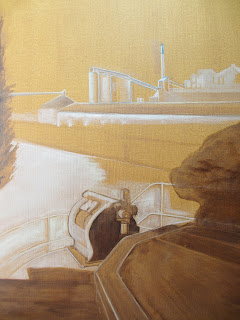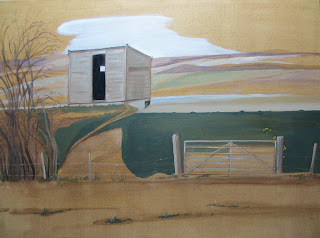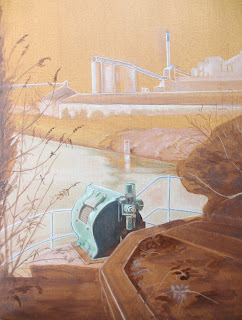Building on from my research into the work of artist Michael Raedecker and others, I have over the last few weeks been exploring my practice through a series of four paintings.
Aim
My previous painting experiments gave me insight into how I would like my painting practice to develop. The key elements which I want to explore further involve the following;
- employing interesting compositions which relate to my theme of natural and man-made landscapes
- ensuring that my personal voice comes through (not just a mirror image of views, but works which reflect my own ideas and ways of working)
- building up the use of negative space to create an atmosphere of mystery and the use of imagination
- using my research into theory and practice (works of other artists) as a base from which to build on
- bringing all these elements together to synthesise into works of art from which I can develop further
Practical
I have learned during my previous experiments that I can develop certain ways of working, including the following:
- working on a mid-tone base so that I can balance lighter and darker tones accordingly
- using oil paint instead of acrylic which will give me more flexibility due to its longer drying time
- by adding colour in a more discerning way
- the use of a limited palette to encourage the mixing of colours (instead of straight from the tube)
- use inspiration from my research into other artists to look at things differently.
Series of Four Oil Studies - Process
I decided to make a series of works in oil paint as a way of providing some consistency into my practice and to concentrate on developing the above points.
I bought four matching canvases of good quality and size (Winsor and Newton). They are landscape in shape and are canvas on board. I felt that board rather than stretched canvas would work well for what I had in mind as it would give a smoother, firmer base.
I selected a limited palette to promote the mixing of my own colours and to provide consistency of results. I used Rembrandt oil colour:
- titanium white
- ultramarine deep
- permanent red medium
- permanent yellow medium
- yellow ochre
- burnt umber
- quinacridone rose.
I mixed burnt umber with equal parts yellow ochre to produce enough a mid-tone as a ground for the four canvases. It was thinned with artist's quality white spirit.
I used a weak solution of burnt umber or white to make line under drawings and then added light and darker tones. I then chose certain elements of the paintings which I wanted to emphasise and developed them using colour.
Line under drawing:
Tonal Under Painting
Outcome
All paintings relate to my case study at South Ferriby
1.
Hide
This painting is inspired by the banks of the Humber Estuary. On a turn in the river bank sits a solitary bird hide. I wanted to create an atmosphere of isolation amid the mists swirling around the base of the building where the land meets the water.
2.
The Lock
3.
Machine
The viewer looks out from behind a machine over the River Ancholme and towards the CEMEX factory. The foreground is in deep shadow, whilst the light glows on the river and factory. Buddleia and other plants have taken hold in the surrounding area.
4.
Shed
In a corner of a field sits a shed, derelict, with its corrugated roof being prised apart by a young adjacent tree. Poles are left discarded to its side. Steel structures tower overhead and the factory buildings disappear into the distance. Here I contrast man-made structures with the force of nature and the natural landscape.
Analysis
Concepts - I think that my choice of subject matter relates well to my ideas about how human activity relates to and interacts with the natural landscape.
Processes - The tonal base provided a good ground for the line and tonal under drawing. Oil paint worked well for me as I could manipulate the paint better than acrylic as I went along and the finish is more pleasing to the eye.
Colour - The restricted palette meant that I mixed my own colours and achieved more subtle results. I was more selective with my use of colour and as a result I was able to emphasis certain features of each painting.
Negative Space - Being aware of, and creating, negative space in my paintings has been a good step forward. It has focused my mind and created room for the viewer to fill in the gaps with their own imagination
Atmosphere - All the paintings have an individuality which I was not previously achieving. I think that this is because I stuck strongly to my theme and used consistent working methods.
Inspiration - I have built on my reading and research into other artists (See Written Proposal and previous Blog entries). In these most recent works I have been inspired by the work of Michael Raedecker, but also by others such as Andrew Wyeth. I also believe that the work I have put into my print making practice has had a beneficial effect on my painting. The line and tonal under drawing stages relate very much to how I approach an etching using aquatint.
Way Forward
This series of paintings has inspired me to progress further with my painting practice building on the ideas and techniques outlined above. I will continue to explore and develop those elements which have been successful, drawing on the inspiration provided by contemporary artists such as Michael Raedecker. I will seek to synthesise the best and find my own personal voice along the way.






No comments:
Post a Comment